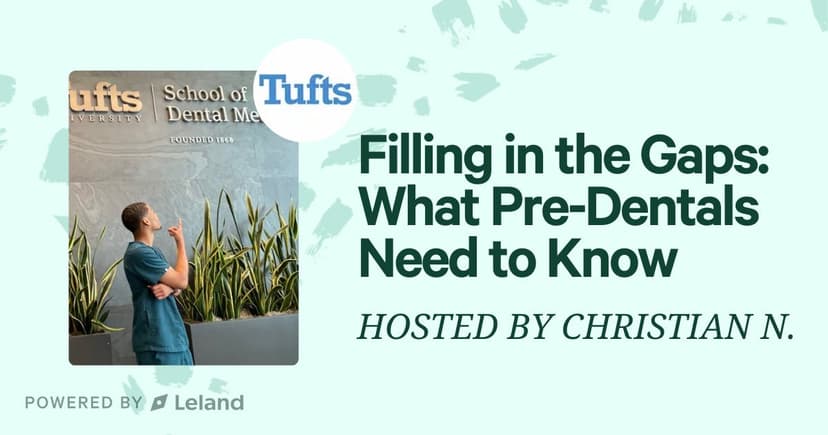Dental School Waitlist Guide: How to Move From Waitlisted to Accepted
Learn how to improve your chances of moving off the dental school waitlist with clear steps, expert advice, and proven strategies to strengthen your application.
Posted June 13, 2025

Join a free event
Learn from top coaches and industry experts in live, interactive sessions you can join for free.
Table of Contents
Being placed on a dental school waitlist can cause a lot of anxiety. I know because I have seen firsthand how stressful it can be for applicants. A dental school waitlist means you were strong enough to impress the admissions committee, but there simply were not enough seats in the class to offer immediate admission. You are still being considered, depending on how many accepted students decline their spots.
Admissions officers usually explain that because more applicants are interviewed than the number of seats available, placing qualified candidates on the waitlist is part of the process. Being waitlisted is not a rejection. It is a "wait and see" status based on how the class fills.
How the Admissions Committee Reviews Waitlisted Candidates:
- Some schools rank their waitlist.
- Others use a non-ranked or tiered waitlist.
- A few perform additional holistic reviews later in the cycle.
Note: Every dental school has a slightly different method, and the admissions office will often outline its specific process when you are notified.
What is a Dental School Waitlist?
A dental school waitlist means you have completed interviews and impressed the admissions committee enough to remain under consideration, but the class is currently full. Schools cannot admit every qualified applicant due to class size limits approved by their accrediting bodies. You should feel honored to reach this stage, many students never get this far.
Yvette Perry, PhD, at the University of Toledo, explained that most candidates who are interviewed are highly qualified, and very few are rejected outright. Being on the waitlist shows your candidacy is strong.
How the Admissions Committee Reviews Waitlisted Candidates
Each school handles the waitlist differently. Some use a ranked waitlist, where candidates are ordered by strength. Others use non-ranked or hybrid systems, combining scores, mission fit, and other factors like residency or alumni connections. Waitlist movement depends heavily on how many accepted students decline offers.
At some schools, dozens of waitlisted applicants are admitted each year. At others, only a handful move off the list. The unpredictability of the process can add to the anxiety, but understanding how schools review the waitlist can help you stay prepared.
Steps After Receiving a Waitlist Notification
First Thing to Do: Confirm Your Interest
Once you're notified of your waitlist status, the first step is to respond promptly. Send a concise, professional letter or email to the admissions office expressing your continued interest in attending their dental school. This isn’t just a formality; it keeps your file active and signals that you’re still a serious candidate.
- Affirm your interest in attending the school if accepted.
- Explain why the program is a strong fit for your goals, mention the curriculum, clinical opportunities, faculty, or location.
- Keep it brief, polished, and specific to that institution. Avoid generic language.
Expert Tip: If the school allows it, consider labeling this as a Letter of Interest. Don’t call it a Letter of Intent unless you’re ready to commit and the school accepts that format.
Example email opening:
Dear [Admissions Officer’s Name],
Thank you for the opportunity to remain on the waitlist for [School Name]. I remain strongly interested in attending your program and would gladly accept a seat if one becomes available. Since submitting my application, I have [brief update]. I believe [School Name]'s strong [feature] aligns closely with my long-term goals in dentistry...
Keep Your File Updated
If the admissions committee allows updates, take the opportunity to submit any new achievements or changes that strengthen your application. These should be meaningful additions, not minor edits or repeated information. Here are acceptable and helpful updates to include:
| Update | Examples |
|---|---|
| Academic Improvements | Higher GPA from recent coursework, improved DAT scores |
| New Roles or Achievements | Leadership positions in student organizations, national awards, and scholarship recognitions |
| Clinical or Dental Office Experience | Volunteer or paid work in a dental office, shadowing hours with new specialties |
| Research Projects | Published papers, presentations, or posters relevant to dentistry |
| Service or Community Involvement | Launching a public health initiative, tutoring pre-dental students, and long-term volunteering |
Important Note: Only submit updates that the school has requested or allows. Review their instructions carefully. Some schools only accept documents through their application portal; others may accept emails. Never assume, always follow instructions exactly.
Stay Professional in All Communication
During the waitlist process, your tone and behavior in communication matter as much as your application file. Every email, phone call, and update reflects on your candidacy.
- Be polite and direct. Avoid emotionally charged language or personal appeals. Admissions officers are evaluating how you handle pressure.
- Don’t over-communicate. One or two well-timed updates or check-ins are acceptable. Weekly emails or excessive phone calls are not.
- Avoid third-party influence. Having alumni, donors, or faculty speak on your behalf, unless specifically requested, can appear inappropriate and raise fairness concerns.
- Check for errors. Typos, formatting mistakes, or misnamed schools in your letters (a common mistake) make you appear careless. Proofread everything.
Mistake to avoid: Don’t copy and paste letters to multiple schools and forget to change the name. Schools notice this, and it weakens your credibility.
Strengthening Your Candidacy While You Wait
Send a Letter of Intent (If Allowed)
Some dental schools allow applicants on the waitlist to send a Letter of Intent. This is a formal statement declaring that if you are accepted, you will attend that specific school. If you decide to send one, do so only if the admissions office explicitly permits it. A well-written letter of intent should:
- Reaffirm your strong interest in attending the school.
- Reference specific aspects of the program, such as clinical training, faculty interests, public health initiatives, or location, that align with your goals in dentistry.
- Include meaningful updates not already in your original application (e.g., a higher GPA, additional shadowing hours, a new leadership role).
- Remain professional and brief, ideally under one page, and free from emotional appeals or generic language.
Important Note: Do not send letters of intent to more than one school. If you say that a school is your top choice and then repeat that to other schools, it damages your credibility and could hurt your candidacy. Admissions officers talk. It’s not worth the risk.
What Not to Include:
- Unverified personal claims (e.g., “I’m the most passionate applicant you’ll meet”)
- Repetition of content from your personal statement
- Overly emotional language (“This school is my dream, and I will never be happy anywhere else.”)
Participate in Meaningful Activities
Being waitlisted doesn’t mean your efforts stop. The admissions committee may review your file again, especially if spots open later in the cycle. Staying productive helps reinforce that you are prepared and focused. Here are activities that make a real impact:
| Activity | Why It Matters |
|---|---|
| Work at a dental office | Shows daily exposure to patient care and commitment to becoming a dentist |
| Volunteer in healthcare settings | Demonstrates service, empathy, and understanding of the broader health field |
| Take new coursework or raise your GPA | Addresses any academic weaknesses and shows resilience |
| Conduct research with university faculty | Strengthens your academic profile and critical thinking skills |
| Hold leadership roles in community or campus groups | Shows initiative, communication skills, and maturity |
Stay Engaged Without Overdoing It
Some students assume constant communication shows persistence. It doesn’t. Admissions officers are managing hundreds of applicants and dozens of files at once. Sending too many emails or calling repeatedly won’t help your case and can hurt it. Here’s a practical and respectful communication schedule during the waitlist process:
- 1–2 emails total during spring to confirm your continued interest and submit important updates.
- 1 additional email if something significant changes (e.g., new DAT score, published research, graduation, promotion).
- Reply promptly to any communication or requests from the school, ideally within 24 hours.
Expert Tip: Keep a copy of every letter, email, or form you send. Use clear file names (e.g., “[YourName] - Letter of Intent - [SchoolName].pdf”) so you’re organized if any faculty or staff reach out.
How Waitlist Policies Vary Between Schools
Deadlines, File Updates, and Contact Protocols
Each dental school sets its own rules for how it manages the waitlist process. Some allow applicants to submit additional letters or updates until a specific cutoff date. Others freeze applications after interviews, meaning you won’t be able to add new information. To stay in good standing with the admissions committee, you must follow each school's:
- Deadlines for sending updates or letters: Some schools accept updates only until early spring (e.g., March or April). Others may allow them through July, depending on how many students withdraw.
- How updates must be submitted: Some require uploads through their application portal (like AADSAS); others will accept direct emails, but only to specific addresses.
- Acceptable forms of communication: Phone calls are rarely encouraged. Most schools prefer email or app-based communication, especially during peak months.
Example: If a school only accepts update letters through their secondary portal, sending it via email, even with good intentions, may violate their process. That can impact how your file is reviewed.
Expert Tip: Following instructions exactly shows the admissions office that you're responsible, respectful, and serious about attending.
Understanding Ranking and Movement
Waitlists are not one-size-fits-all. Some schools maintain a ranked list, meaning your position is determined by your original application score or interview performance. Others use an unranked or tiered system, making decisions based on multiple factors, such as:
- Mission alignment (e.g., commitment to underserved communities)
- Residency status
- Academic improvement
- Alumni connections or faculty recommendations
| Waitlist Type | How It Works |
|---|---|
| Ranked | Candidates are ranked based on scores. Movement is sequential (e.g., offer goes to #1, then #2, etc.) |
| Unranked | No fixed order. The committee re-evaluates based on updated needs or file reviews |
| Tiered | Divided into groups like “High Priority” and “General Pool.” Offers may go first to top-tier candidates based on mission fit or other criteria |
Note: Even if you’re high on a ranked list, that doesn’t guarantee an offer. In one year, the 30th person might get admitted. The next year, the 10th person might not, simply because fewer spots opened up.
Mistakes to Avoid
- Involving third parties like family, alumni, donors, or elected officials to advocate on your behalf. Most schools explicitly discourage this. It raises equity concerns and creates an unfair process.
- Sending repetitive messages or unnecessary documents. Only send updates when something substantial has changed; don’t resend the same letter multiple times.
- Missing school-specific instructions or deadlines. Each school posts its own process. Not following it, even by accident, signals a lack of attention to detail.
- Using generic content that looks like a copy-paste template. Schools can tell when your letter isn’t specific. If you include another university's name or forget to personalize your update, it reflects poorly on your application.
Note: Every mistake sends a signal, and in a competitive process with limited spots, small errors can push your candidacy out of the running.
When You Receive a Request or an Offer
Respond Quickly to Any Requests
If the admissions office contacts you while you are on the dental school waitlist, you need to respond as soon as possible. Most requests are time-sensitive and relate to your eligibility for admission. Always make sure that:
- Your email address, phone number, and mailing address are current in the school’s system.
- You check your email and voicemail at least once per day during the spring and summer months.
- You respond to any school communication within 24 hours whenever possible.
Even a minor delay can cost you a seat. Some schools move quickly to fill spots and will offer the opportunity to the next candidate if you don’t respond promptly.
Be Ready to Make a Decision Quickly
If you are offered admission from the waitlist, you may have only a few days, or in some cases 24 to 48 hours, to accept or decline. Dental schools must fill their class quickly to prepare for orientation, financial aid processing, and clinical placements. When you receive an offer, it’s smart to immediately ask the admissions officers the following:
- When is the deadline to accept the offer?
- What deposit, if any, is required to hold your spot?
- When does orientation or coursework officially begin?
- How and when should you submit required documents (health forms, transcripts, etc.)?
- Who should you speak to about financial aid or scholarships?
What to Do If You Don’t Get Admitted This Cycle
Reflect and Plan Your Next Steps
Not moving off the dental school waitlist is disappointing, but it does not mean you are unqualified. Many highly capable candidates are turned away each year because class sizes are limited, and many schools overfill cautiously.
If you are not admitted, the first step is to speak politely with the admissions office and ask if they offer feedback. Some institutions provide general advice about strengthening future applications, while others may not comment. Either way, reaching out shows maturity and professionalism. Common areas where applicants often improve between cycles include:
| Area to Strengthen | Impact on Candidacy |
|---|---|
| Raising your GPA | Shows academic ability and readiness for dental school coursework |
| Improving DAT scores | Strengthens academic metrics that admissions committees heavily weigh |
| Gaining more clinical experience | Deepens your exposure to dentistry and shows sustained interest |
| Taking on leadership or service roles | Builds a well-rounded application and highlights interpersonal skills |
Alternative Paths to Strengthen Your Application
If you want to continue building your profile, there are several proven paths that can significantly improve your chances in the next admissions cycle.
| Alternative Path | How It .,Strengthens You |
|---|---|
| Post-baccalaureate program | Improves GPA with focused science coursework and shows academic dedicationxv/vv/csA |
| Master's program in biomedical sciences | Adds an advanced credential and demonstrates the ability to handle graduate-level material |
| Job experience at a dental office | Builds hands-on knowledge of dentistry, patient care, and professional settings |
| Research assistant roles at a university | Adds scholarly experience and may lead to publications or conference presentations |
Reapplying Strategically
If you plan to apply again, you need to treat it like building a new application, not recycling the old one. Schools keep detailed records, and they will recognize if your submission hasn’t improved.
- Rewrite personal statements to reflect new experiences and insights.
- Secure updated letters of recommendation, especially from professors, dentists, or supervisors who can speak to your recent achievements.
- Include significant new accomplishments such as higher academic scores, expanded clinical hours, leadership roles, or research contributions.
- Prepare for interviews earlier, practicing with advisors, mentors, or admissions coaches.
Expert Advice for Students Facing Waitlist Anxiety
Tip 1: Set Weekly Goals to Stay Focused
Each Sunday, list three small goals tied to professional growth—like shadowing at a dental office, studying for the DAT, or attending a webinar. Track your progress weekly. This keeps you moving forward and helps ease anxiety by giving you control over your growth.
Tip 2: Create a 48-Hour Acceptance Plan
Make a checklist now for what to do if you get an acceptance call. Plan for finances, housing, transportation, and needed documents. Having everything ready lets you act fast and shows admissions officers you’re serious.
Tip 3: Send One Strong Update in Late Spring
If allowed, send one well-timed update letter between April and June. Focus on real improvements like a higher GPA, new clinical experience, or published research. A strong update at the right time can help keep you top of mind.
Tip 4: Limit Email and Portal Checking
Only check your email and application portals twice a day. Set timers if needed. Constant checking feeds anxiety, while limiting it helps you stay focused on real progress.
Tip 5: Build Your Story While You Wait
Keep a record of new experiences, like dental office work, volunteering, or leadership roles. Even if you don’t get admitted this cycle, you’ll have strong material for essays, interviews, and reapplication.
Final Thoughts
Being placed on a dental school waitlist can feel frustrating, but it also means you have the skills, experience, and potential that schools are still seriously considering. Use this waiting period wisely by staying engaged, building new achievements, and communicating professionally with admissions offices. Whether you are accepted this cycle or reapply in the next, the effort you put in now will only make you a stronger, more prepared candidate and a better future dentist. Stay focused on growth, stay patient, and remember that your journey toward dentistry is still very much alive.
Get Help From a Dental School Admissions Coach
If you are on the waitlist or getting ready to reapply, working with a dental school admissions coach can make a big difference. A coach can help you write stronger letters, prepare for interviews, and build a better plan to improve your chances. Get expert help and move closer to getting accepted.
For more related articles about dental school applications, waitlists, and admissions tips, check out these helpful guides:
- Is Dental School Worth It? The Pros, Cons, & How to Decide
- What Do You Learn in Dental School?
- How to Get Into Dental School: 5 Things to Do
- How to Choose a Dental School Admissions Coach: 5 Important Factors
- Dental School Requirements: What You Need to Apply
FAQs About the Dental School Waitlist
How likely is it to get off a dental school waitlist?
- It depends on the school, the size of the class, and how many accepted students give up their spots. Some institutions take many students off the waitlist every year. Others may only take a few. It’s not something you can predict. Staying professional and keeping your file updated gives you the best chance.
Should I send multiple letters to different schools?
- You can send letters of interest to different schools if you follow their rules. But you should only send a letter of intent—where you promise to attend if admitted—to one school. Sending a letter of intent to more than one school can damage your reputation with the admissions office.
What should I include in an update letter?
- An update letter should include real progress that strengthens your candidacy. Good examples are a higher GPA, better DAT scores, new work at a dental office, leadership roles, or research achievements. Keep the letter short, positive, and directly tied to how you have grown since you submitted your application.
Is attending pre-dent events or visiting the school helpful?
- Yes. Attending pre-dent events, open houses, or visiting the university can show serious interest and help you build connections. Some admissions officers notice students who take the time to visit, meet faculty, and ask thoughtful questions. It can also give you good material to use in your letters or interviews.
Does being waitlisted hurt my chances for future applications?
- No. Being placed on the waitlist shows that you were a strong candidate. Many students who were waitlisted one year are admitted in the next cycle after improving their applications. Schools often treat reapplicants as new applicants, so showing growth in scores, experience, and leadership matters.
Browse hundreds of expert coaches
Leland coaches have helped thousands of people achieve their goals. A dedicated mentor can make all the difference.















